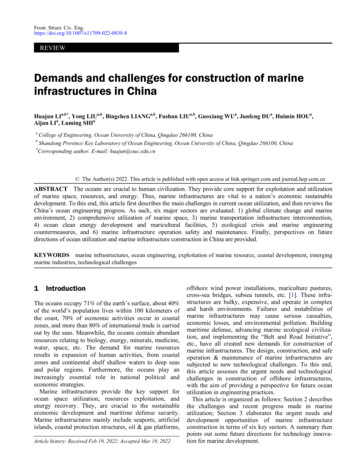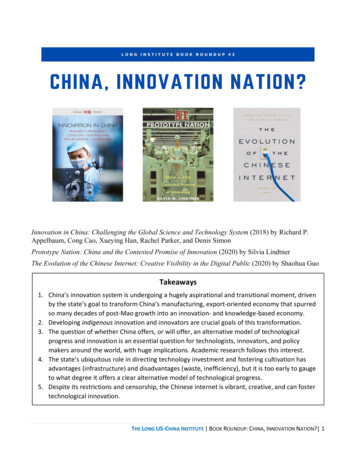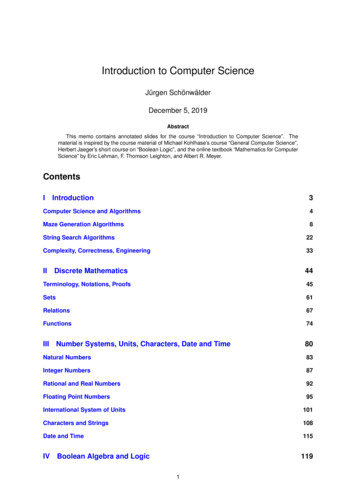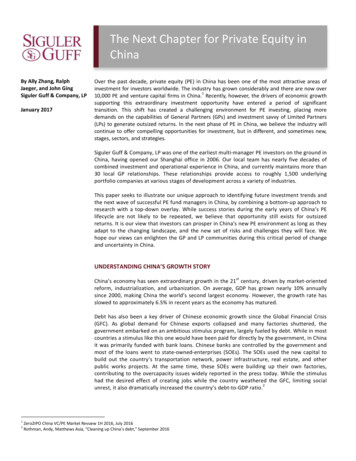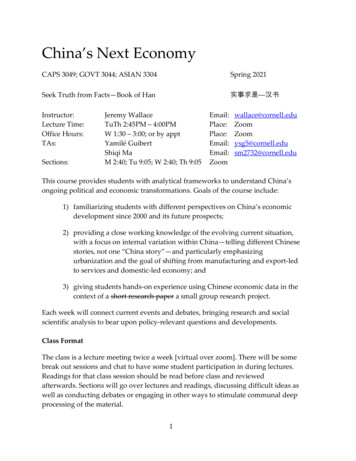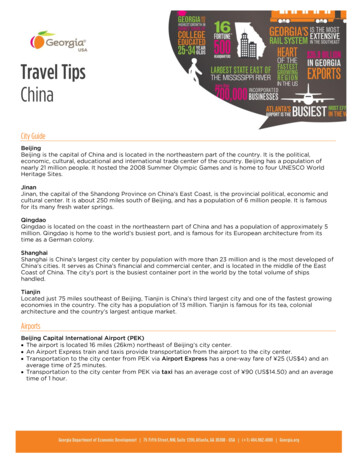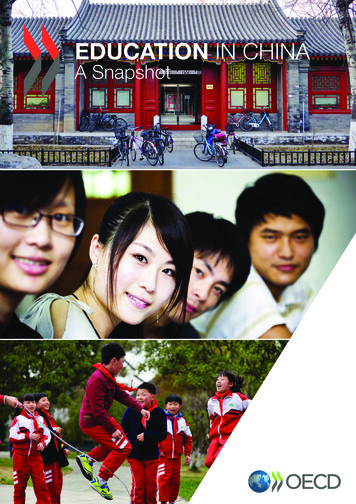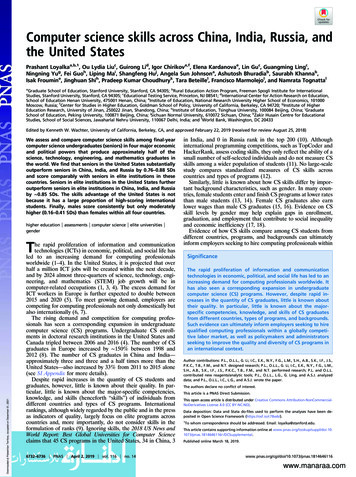
Transcription
Computer science skills across China, India, Russia, andthe United StatesPrashant Loyalkaa,b,1, Ou Lydia Liuc, Guirong Lid, Igor Chirikove,f, Elena Kardanovae, Lin Guc, Guangming Lingc,Ningning Yug, Fei Guoh, Liping Mai, Shangfeng Huj, Angela Sun Johnsona, Ashutosh Bhuradiab, Saurabh Khannab,Isak Froumine, Jinghuan Shih, Pradeep Kumar Choudhuryk, Tara Beteillel, Francisco Marmolejol, and Namrata TognattalaGraduate School of Education, Stanford University, Stanford, CA 94305; bRural Education Action Program, Freeman Spogli Institute for InternationalStudies, Stanford University, Stanford, CA 94305; cEducational Testing Service, Princeton, NJ 08541; dInternational Center for Action Research on Education,School of Education Henan University, 475001 Henan, China; eInstitute of Education, National Research University Higher School of Economics, 101000Moscow, Russia; fCenter for Studies in Higher Education, Goldman School of Policy, University of California, Berkeley, CA 94720; gInstitute of HigherEducation Research, University of Jinan, 250022 Jinan, Shandong, China; hInstitute of Education, Tsinghua University, 100084 Beijing, China; iGraduateSchool of Education, Peking University, 100871 Beijing, China; jSichuan Normal University, 610072 Sichuan, China; kZakir Husain Centre for EducationalStudies, School of Social Sciences, Jawaharlal Nehru University, 110067 Delhi, India; and lWorld Bank, Washington, DC 20433Edited by Kenneth W. Wachter, University of California, Berkeley, CA, and approved February 22, 2019 (received for review August 25, 2018)We assess and compare computer science skills among final-yearcomputer science undergraduates (seniors) in four major economicand political powers that produce approximately half of thescience, technology, engineering, and mathematics graduates inthe world. We find that seniors in the United States substantiallyoutperform seniors in China, India, and Russia by 0.76–0.88 SDsand score comparably with seniors in elite institutions in thesecountries. Seniors in elite institutions in the United States furtheroutperform seniors in elite institutions in China, India, and Russiaby 0.85 SDs. The skills advantage of the United States is notbecause it has a large proportion of high-scoring internationalstudents. Finally, males score consistently but only moderatelyhigher (0.16–0.41 SDs) than females within all four countries.higher educationgender assessments computer science elite universities Downloaded at Palestinian Territory, occupied on December 31, 2021The rapid proliferation of information and communicationtechnologies (ICTs) in economic, political, and social life hasled to an increasing demand for computing professionalsworldwide (1–4). In the United States, it is projected that overhalf a million ICT jobs will be created within the next decade,and by 2024 almost three-quarters of science, technology, engineering, and mathematics (STEM) job growth will be incomputer-related occupations (1, 3, 4). The excess demand forICT workers in Europe is further expected to double between2015 and 2020 (5). To meet growing demand, employers arecompeting for computing professionals not only domestically butalso internationally (6, 7).The rising demand and competition for computing professionals has seen a corresponding expansion in undergraduatecomputer science (CS) programs. Undergraduate CS enrollments in doctoral research institutions in the United States andCanada tripled between 2006 and 2016 (4). The number of CSgraduates in Europe increased by 150% between 1998 and2012 (8). The number of CS graduates in China and India—approximately three and three and a half times more than theUnited States—also increased by 33% from 2011 to 2015 alone(see SI Appendix for more details).Despite rapid increases in the quantity of CS students andgraduates, however, little is known about their quality. In particular, little is known about the major-specific competencies,knowledge, and skills (henceforth “skills”) of individuals fromdifferent countries and types of CS programs. Internationalrankings, although widely regarded by the public and in the pressas indicators of quality, largely focus on elite programs acrosscountries and, more importantly, do not consider skills in theformulation of ranks (9). Ignoring skills, the 2018 US News andWorld Report: Best Global Universities for Computer Scienceclaims that 45 CS programs in the United States, 34 in China, 36732–6736 PNAS April 2, 2019 vol. 116 no. 14in India, and 0 in Russia rank in the top 200 (10). Althoughinternational programming competitions, such as TopCoder andHackerRank, assess coding skills, they only reflect the ability of asmall number of self-selected individuals and do not measure CSskills among a wider population of students (11). No large-scalestudy compares standardized measures of CS skills acrosscountries and types of programs (12).Similarly, little is known about how CS skills differ by important background characteristics, such as gender. In many countries, female students enter and finish CS programs at lower ratesthan male students (13, 14). Female CS graduates also earnlower wages than male CS graduates (15, 16). Evidence on CSskill levels by gender may help explain gaps in enrollment,graduation, and employment that contribute to social inequalityand economic inefficiency (17, 18).Evidence of how CS skills compare among CS students fromdifferent countries, programs, and backgrounds can ultimatelyinform employers seeking to hire computing professionals withinSignificanceThe rapid proliferation of information and communicationtechnologies in economic, political, and social life has led to anincreasing demand for computing professionals worldwide. Ithas also seen a corresponding expansion in undergraduatecomputer science (CS) programs. However, despite rapid increases in the quantity of CS graduates, little is known abouttheir quality. In particular, little is known about the majorspecific competencies, knowledge, and skills of CS graduatesfrom different countries, types of programs, and backgrounds.Such evidence can ultimately inform employers seeking to hirequalified computing professionals within a globally competitive labor market, as well as policymakers and administratorsseeking to improve the quality and diversity of CS programs inan international context.Author contributions: P.L., O.L.L., G. Li, I.C., E.K., N.Y., F.G., L.M., S.H., A.B., S.K., I.F., J.S.,P.K.C., T.B., F.M., and N.T. designed research; P.L., O.L.L., G. Li, I.C., E.K., N.Y., F.G., L.M.,S.H., A.B., S.K., I.F., J.S., P.K.C., T.B., F.M., and N.T. performed research; P.L. and O.L.L.contributed new reagents/analytic tools; P.L., O.L.L., L.G., G. Ling, and A.S.J. analyzeddata; and P.L., O.L.L., I.C., L.G., and A.S.J. wrote the paper.The authors declare no conflict of interest.This article is a PNAS Direct Submission.This open access article is distributed under Creative Commons Attribution-NonCommercialNoDerivatives License 4.0 (CC BY-NC-ND).Data deposition: Data and Stata do-files used to perform the analyses have been deposited in Open Science Framework (https://osf.io/c78wb/).1To whom correspondence should be addressed. Email: loyalka@stanford.edu.This article contains supporting information online at 116/-/DCSupplemental.Published online March 18, ww.manaraa.com
Downloaded at Palestinian Territory, occupied on December 31, 2021Data and MethodsThe Institutional Review Board approval for this research project was approved by Stanford University (IRB#31585). We selected nationally representative, random samples of seniors from undergraduate (bachelor’sdegree) CS programs in China, India, and Russia (see SI Appendix for moredetails). We first identified all undergraduate CS programs from China, India, and Russia that had similar course requirements and content with eachother and with undergraduate CS programs in the United States. In choosingthe sampling frame for each country, we did a careful review of all potentialCS majors in each country, and only included majors that taught core CScoursework. Like the United States, the standard number of years forbachelor’s degrees in CS programs is 4 y in China, India, and Russia. While it istrue that many bachelor’s degree majors in India are 3 y, this is not true fortechnical (CS and engineering related) majors, which are 4 y.Using administrative data on the population frame of all higher educationinstitutions with undergraduate CS programs in each country, we thensampled institutions that offered these comparable CS programs. From China,we randomly selected six institutions from each of six representative provinces (36 institutions). From India, we purposefully sampled five institutionsfrom each of three representative states (15 institutions). From Russia, wetook a stratified national random sample of 34 institutions. Our sample of CSstudents from China, and perhaps India, may be of slightly higher math andscience ability ( 0.20–0.25 SDs) than the population of CS students in thosecountries. As such, the estimates of CS skill levels of CS seniors in thosecountries may be slight overestimates. We provide further details on thenational representativeness of the China and India samples in SI Appendix.The national samples covered elite and nonelite programs in each country.In China, elite programs were identified as those in Project 985 or 211 universities. In India, elite programs were identified as those in India Institutes ofTechnology, National Institutes of Technology, and other institutions thatranked in the top 100 of the National Institutional Ranking Frameworkrankings. In Russia, elite programs were identified as those in National Research Universities, “5–100” universities, and Federal universities. Thesehigh-profile elite programs teach different proportions of the total numberof CS undergraduates in each country (see SI Appendix for more details). Thecomparisons of elite universities favor India because students attending eliteCS programs in India are approximately among the top 4% of CS undergraduates nationally, while students attending elite CS programs in China,Russia, and the United States are approximately among the top 19–26% ofCS undergraduates in their respective countries.We next randomly sampled smaller administrative units (departments andclasses) within each of the sampled programs in China, India, and Russia andselected all seniors in those administrative units (see SI Appendix for moredetails). We randomly assigned half of the selected seniors to take the samestandardized CS examination. Altogether, 678 seniors from China (119 fromelite programs), 364 seniors from India (71 from elite programs), and 551seniors from Russia (116 from elite programs) took the examination. Toensure representativeness, we adjusted our analytical estimates and SEs forsurvey design features, including multistage sampling and probability sampling weights (see SI Appendix for more details).We also obtained assessment data on 6,847 seniors from a representativesample of CS programs in the United States (607 from elite programs). Thesample and population of CS programs in the United States were similar interms of the number and percentage of CS degrees awarded (see SI Appendixfor more details). The distributions of average ACT/SAT equivalent scores ofadmitted students in 2015–2016 were also similar across the sample andpopulation of CS programs (see SI Appendix for more details). Elite programsin the United States were identified as those from colleges with averageACT/SAT equivalent scores of 1,250 (of 1,600) or higher; these programsproduce 19% of the country’s CS graduates (19).Sampled seniors in the four countries all took a 2-h, computer-based,standardized CS examination from the “Major Field Test” suite of assessments designed by Educational Testing Service (ETS). The examination assesses how well CS seniors master CS-related concepts, principles, andknowledge. It consists of 66 multiple-choice questions, some of which areLoyalka et al.grouped in sets and are based on materials such as diagrams, graphs, andprogram fragments. The test does not assume knowledge of any particulartype of software or programming language. In fact, it uses pseudocode that ismeant to be easily understood by CS students regardless of program or country.Examination content areas include discrete structures, programming, algorithms and complexity, systems, software engineering, information management, and “other” (SI Appendix, Table S1). Content areas and their proportionsare aligned with the Association for Computing Machinery (ACM)/Institute ofElectrical and Electronics Engineers (IEEE) authoritative international standard,Computer Science Curricula 2013, 2008, and 2003 (20) (SI Appendix, Table S3)and with the official curricula guidelines for domestic CS programs in China,India, and Russia (SI Appendix, Table S4).We took several steps to ensure that examination-taking conditions weresimilar for all students. First, we provided the same incentives to students. Inparticular, students were given the option of receiving an individualizedreport of their examination performance. Second, to address concerns aboutstudent motivation in taking the examination, we conducted robustnesschecks in which we excluded a small minority of students (1.7%) that did notanswer at least 75% of the items. Results are substantively the same whetheror not we exclude these students. Third, the examination was translated intothe language of program instruction. To minimize bias due to differences inlanguage, we followed a rigorous multistage translation and translationreview process (see SI Appendix for more details). Fourth, examination scoreswere scaled to be comparable across countries (see SI Appendix for moredetails). To examine relative skill levels between countries and institutions interms of effect sizes, we converted each student’s examination score into az-score by subtracting the mean and dividing by the SD of the fourcountry sample.The de-identified dataset and analysis code for replication have beendeposited at Open Science Framework (https://osf.io/c78wb/) (21).SOCIAL SCIENCESa globally competitive labor market, as well as policymakers andadministrators seeking to improve the quality and diversity ofprograms in an international context. As such, this study compares the skills of fourth and final-year (senior) CS undergraduates from different backgrounds and programs across fourmajor economic and political powers that train half of theworld’s STEM graduates: China, India, Russia, and the UnitedStates (13).ResultsSeniors in the United States exhibit much higher levels of CSskills than seniors in China, India, and Russia (Fig. 1). Specifically, seniors in the United States score 0.76 SDs (P 0.000)higher than seniors in China, 0.88 SDs (P 0.000) higher thanseniors in India, and 0.77 SDs (P 0.000) higher than seniors inRussia. In contrast, differences in CS skills between seniors inChina, India, and Russia are small and statistically insignificant.[The results remain virtually unchanged when we drop studentsfrom CS majors with nonstandard names (in particular, InformationSecurity or Information Engineering in China or Information Security in Russia) from the analysis.]Fig. 1. CS skills across China, India, Russia, and the United States. Meanestimates for China, India, and Russia are each statistically lower than themean estimate for the United States (P 0.000). Mean estimates are notstatistically different between China and India (P 0.435), China and Russia(0.914), and India and Russia (P 0.509). Estimates are reported as effectsizes (in SD units). Scaled CS examination scores were converted into z-scoresusing the mean and SD of the entire cross-national sample of examinationtakers. As such, the overall mean of the standardized score across all fourcountries is zero. SEs are adjusted for clustering at the institution (university/college) level.PNAS April 2, 2019 vol. 116 no. 14 6733www.manaraa.com
Fig. 2. CS skills by elite and nonelite institutions: China, India, Russia, and the United States. Within each country, the mean estimate for elite institutions ishigher than the mean estimate for nonelite institutions (China, P 0.063; India, P 0.174; Russia, P 0.084; United States, P 0.000). The mean estimate forelite institutions in China, India, and Russia combined is lower than the mean estimate for elite (ACT/SAT equivalent 1,250; approximately the top quintile)institutions in the United States (P 0.008). Mean estimates for nonelite institutions in China, India, and Russia are each lower than mean estimate fornonelite institutions in the United States (P 0.000). Mean estimates for elite institutions across China, India, and Russia are not statistically different (P 0.100). Mean estimates for nonelite institutions across China, India, and Russia are also not statistically different (P 0.100). Estimates reported as effect sizes(in SD units). Scaled CS examination scores converted into z-scores using the mean and SD of the entire cross-national sample of examination takers. As such,the overall mean of the standardized score across all four countries is zero. SEs adjusted for clustering at the institution (university/college) level.Downloaded at Palestinian Territory, occupied on December 31, 2021Although seniors in elite programs score much higher thanseniors in nonelite programs in China, India, and Russia, theystill score lower than seniors in the United States (Fig. 2). Specifically, the average senior in the United States scores 0.15–0.25SDs higher than seniors from elite programs in China, India, andRussia (P 0.100). Seniors from elite program in the UnitedStates score much higher than seniors from elite programs in theother three countries (0.85 SDs, P 0.008).The substantial advantage of CS students in the United Statesis not driven by the presence of international students. We distinguish between domestic (versus international) students in theUnited States sample in two ways: (i) students who reported thattheir best language is English or English and another languageequally, 94.4% of all sampled United States students; and (ii)students who responded that their best language is English(only), 89.1% of all sampled United States students. [We proxyfor “domestic” versus “international” in the United States sample by using a survey question on the self-reported best languageof test takers. Specifically, the survey question asked students:“Do you communicate better in English than in another language?” Student’s had three response options: (i) English; (ii)other language, and (iii) both equal. Furthermore, by way ofcomparison, the National Science and Engineering (NS&E) Indicators define “domestic” CS students as having US citizenshipor permanent residence. According to the NS&E indicators,95% of CS bachelor’s degree graduates from the United StatesFig. 3. CS skills across China, India, Russia, and the United States after adjusting for United States student’s’ self-reported best language. The mean estimateof CS skills among United States students (“All”) is substantively the same as both (i) United States students who reported their best language is English orEnglish and another language equally (English/Bilingual: 94.4% of all sampled United States students); and (ii) United States students who reported their bestlanguage is English only (89.1% of all sampled United States students). The mean estimates of CS skills for each of these categories of United States studentsare higher those of China, India, and Russia (in each case, P 0.000). Estimates reported as effect sizes (in SD units). Scaled CS examination scores convertedinto z-scores using the mean and SD of the entire cross-national sample of examination takers. As such, the overall mean of the standardized score across allfour countries is zero. SEs adjusted for clustering at the institution (university/college) level.6734 a et al.www.manaraa.com
Downloaded at Palestinian Territory, occupied on December 31, 2021from 2011 to 2015 (the years that correspond to the UnitedStates sample data) were reported by colleges as being “domestic” (13). We use the additional, stricter definition of “domestic” as students who report their best language as Englishonly in Fig. 3, because it is possible that some students designated as “domestic” CS graduates in the NS&E indicators mayhave become citizens or permanent residents before graduatingfrom college.] Fig. 3 reports the average CS skill levels for thetwo groups of domestic students (English/bilingual and Englishonly) in the United States sample, along with that for the totalUnited States sample. The average CS skill levels are extremelysimilar among the three groups (0.157 SDs, 0.164 SDs, and 0.192SDs). Given the small differences, the magnitude and significance of the gaps between each group of United States studentson the one hand, and China, India, and Russia, respectively, onthe other, are virtually the same.Finally, we find consistent but moderate differences in CSskills between female and male students within all four countries.Males score 0.15 SDs higher than females in China (P 0.093),0.24 SDs higher in India (P 0.077), 0.25 SDs higher in Russia(0.022), and 0.41 SDs higher in the United States (P 0.000).The within-country gender gaps in CS skills, while significant, aregenerally smaller than the skill gaps between the United Statesand other countries as well as between elite and nonelite programs. Females in the United States score 0.35–0.42 SDs higherthan males in China, India, or Russia (P 0.000) and 0.52–0.67SDs higher than females in China, India, or Russia (P 0.000).Female students from the United States also, on average, scorecomparably with students in elite programs in the three othercountries (P 0.100).DiscussionThe above results indicate that undergraduate students at theend of their CS programs in the United States have much higherlevels of CS skills than their counterparts in three major economic and political powers: China, India, and Russia. Seniorsfrom the average CS program in the United States score farahead of CS seniors from the average program and are on parwith seniors from elite programs from these three countries.Furthermore, seniors from the top quintile of CS programs in theUnited States are far ahead of seniors from elite CS programs inthe other countries. Notably, the advantage of the United StatesLoyalka et al.is not because its CS programs have a large number of highlyskilled international students.The results, when viewed in the context of the number of CSgraduates emerging from different CS programs across countries, have implications for the global supply of computing professionals. The 65,000 CS graduates from the United States areoutnumbered, but are much more skilled, on average, than thegraduates from China ( 185,000), India ( 215,000), and Russia( 17,000) (see SI Appendix for more details). United Statesgraduates only face competition from a much smaller cadre ofelite program graduates in China ( 33,000), India ( 8,000), andRussia ( 4,000). A substantial number of CS graduates fromselective programs in the United States further face little competition, even from the other countries’ elite programs.The results also suggest that the CS skill gains made in CSprograms vary considerably across countries. The math and science skill levels of entering CS freshmen are much higher inChina than in Russia, somewhat higher in Russia than in theUnited States, and much higher in Russia than in India.* [Although no comparative cross-country data have been collectedon the math and science skills of United States CS freshmen, wecan approximate differences in the math and science skills ofprospective CS freshmen in Russia and the United States byusing the 2015 TIMSS Advanced dataset (22). Using the dataset,we find that among “advanced” high school seniors reporting anintention to major in CS in college, students in Russia score 0.335 SDs higher in math and 0.732 SDs higher in physics thanstudents in the United States. The larger gap in physics compared with math makes sense since high school students inRussia have several years of coursework in physics, while highschool students in the United States generally have 1 y ofcoursework in physics (23). According to the regular 2015TIMSS data, before high school, the average eighth grader inRussia scores 0.20 SDs higher in math and 0.15 SDs higher inscience than the average eighth grader in the United States (24,25). Similar comparative data do not exist between the Chinaand the United States or between India and the United States.]That China, India, and Russia have comparable CS skill levels bySOCIAL SCIENCESFig. 4. CS skills by gender: China, India, Russia, and the United States. Within each country, males score significantly higher than females (China, P 0.093;India, P 0.077; Russia, P 0.022; USA, P 0.000). Estimates reported as effect sizes (in SD units). Scaled CS examination scores converted into z-scores usingthe mean and SD of the entire cross-national sample of examination takers. As such, the overall mean of the standardized score across all four countries iszero. SEs adjusted for clustering at the institution (university/college) level.*Loyalka P, et al. (2018) Skills in college: China, India, Russia, and the United States.Working paper.PNAS April 2, 2019 vol. 116 no. 14 6735www.manaraa.com
Downloaded at Palestinian Territory, occupied on December 31, 2021we are unable to explore possible reasons here, the potentiallyhigher skill gains of CS students in the United States comparedwith the other three countries could be due to higher qualityteaching or stronger linkages between college performance andemployment outcomes.Finally, despite the substantial focus of policymakers and researchers on gender inequality in CS, within-country gender gapsin skills are moderate compared with skill gaps across countriesor programs (Fig. 4). The gender gap in skills does indicate thatmore effort is needed to attract higher-achieving female studentsinto CS and ensure that they have equal opportunities to receivea quality education. The within-country gender gaps in skills aresmall enough, however, that they may explain little about gendergaps in CS graduates’ labor market outcomes (28, 29).the end of college even though they start with different levels ofmath and science skills, suggests that program quality is lowest inChina and highest in India. Although there is a much greaterdegree of self-selection into and out of CS programs in theUnited States than in the other three countries (23), the fact thatprospective college students in the United States have likelysimilar math and science levels as students in Russia, as well aslittle pretertiary training in CS, implies that skill gains associatedwith attending CS programs in the United States are high. [In theyears during which the students in our United States sampleattended high school, the percentage of US high school studentsthat earned any CS course credit was relatively small (19% in2009) (26). Most prominently, an average of 20,934 high schoolstudents took the AP CS examination each year from 2007 to2011 (27). If we were to assume that all AP CS examinationtakers from 2007 to 2011 majored in CS in college, then approximately one-third of senior CS students from 2011 to 2015received some preparatory CS training in high school.] AlthoughACKNOWLEDGMENTS. We greatly appreciate research funding from Eric(ShiMo) Li, the Basic Research Program of the National Research UniversityHigher School of Economics, and the All India Council for Technical Education.1. Kaczmarczyk L, Dopplick R (2014) Rebooting the Pathway to Success: PreparingStudents for Computing Workforce Needs in the United States (Association forComputing Machinery, New York).2. Zhang M, Zhang L (2014) Undergraduate IT education in China. ACM Inroads 5:49–55.3. Fayer S, Lacey A, Watson A (2017) STEM Occupations: Past, Present, and Future (Bureau of Labor Statistics, Washington, DC).4. Computing Research Association (2017) Generation CS: Computer science undergraduateenrollments surge since 2006. Available at https://cra.org/data/Generation-CS/. AccessedJuly 8, 2018.5. Hüsing T, Korte WB, Dashja E (2015) e-Skills in Europe: Trends and Forecasts for theEuropean ICT Professional and Digital Leadership Labour Markets (2015-2020) (Empirica, Bonn, Germany).6. Bound J, Braga B, Golden JM, Khanna G (2015) Recruitment of foreigners in themarket for computer scientists in the United States. J Labor Econ 33(Suppl 1):S187–S223.7. Kerr SP, Kerr W, Ӧzden Ç, Parsons C (2016) Global talent flows. J Econ Perspect 30:83–106.8. Organisation for Economic Co-operation and Development (2018) ISCED 1997 data:2000-2012. OECD.Stat. Available at https://stats.oecd.org/Index.aspx?DatasetCode RGRADSTY.Accessed June 9, 2018.9. Marginson S (2014) University rankings and social science. Eur J Educ 49:45–59.10. US News (2018) Best global universities for computer science. US News. Available versities/computer-science. AccessedAugust 7, 2018.11. Trikha R (2016) These universities are training the world’s top coders. Fast Company.Available at ties-are-trainingthe-worlds-top-coders. Accessed August 7, 2018.12. Zlatkin-Troitschanskaia O, Shavelson RJ, Kuhn C (2015) The international state ofresearch on measurement of competency in higher education. Stud High Educ 40:393–411.13. National Science Board (2018) Science and Engineering Indicators 2018 (NationalScience Foundation, Alexandri
TIMSS data, before high school, the average eighth grader in Russia scores 0.20 SDs higher in math and 0.15 SDs higher in science than the average eighth grader in the United States (24, 25). Similar comparative data do not exist between the China and the United States or between India and the United States.]

